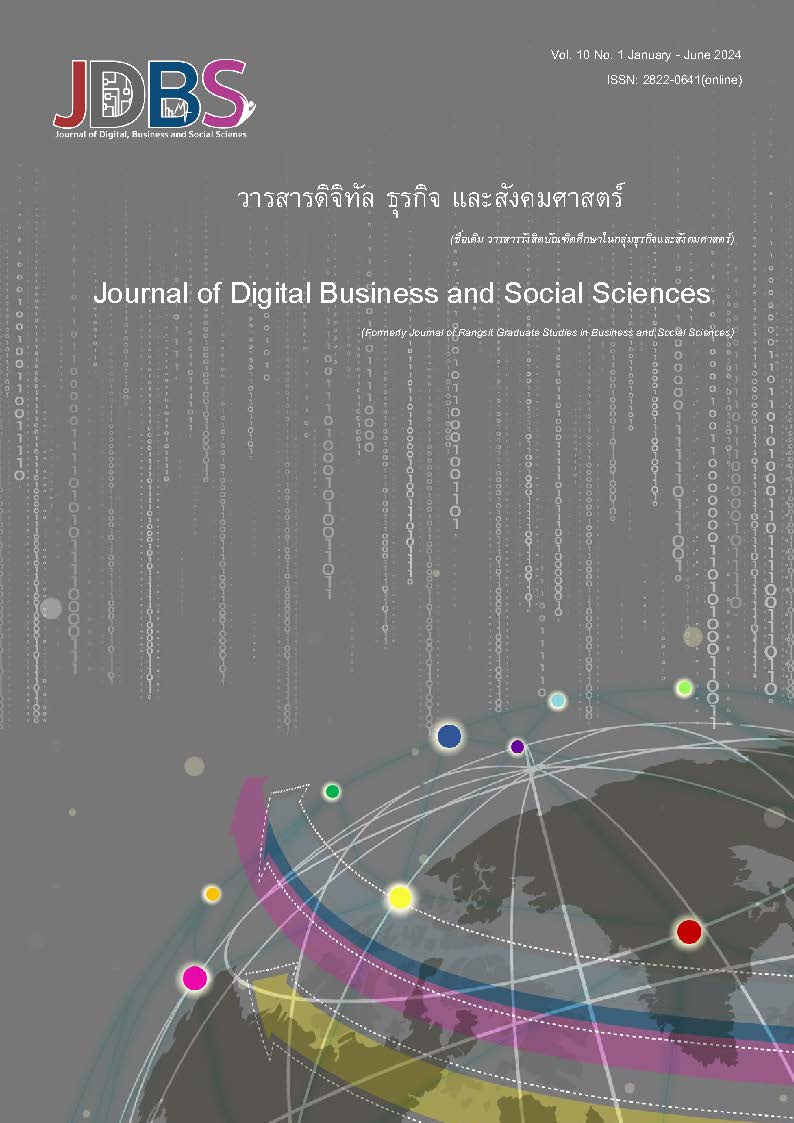CEO CHARACTERISTICS AND CORPORATE PERFORMANCE: A CASE STUDY OF MARKET FOR ALTERNATIVE INVESTMENT IN THAILAND
Abstract
This study’s main objective is to study the relationship between the characteristics of the chief executive officers and the performance of companies listed on the MAI Stock Exchange. Data on the characteristics of both chief executive officers and executive board members, including the shareholding proportion are used in this study. The data includes information regarding characteristics and shareholding proportion in the companies from the Info Director Management Report in Report 56-1 for the year 2019-2020, a total of 176 firm-year observations. The study employs a multiple regression analysis. The dependent variables of the study are return on assets (ROA) and return on equity (ROE). The characteristics of the CEO are gender, age, education, experience in the current position, experience in the field, duo position, field of study, family business, and shareholding proportion. The results of this study found that only three variables presenting the significance to the dependent variables. The shareholding proportion variable (positive impact) and family business variable (negative impact) present the statistical significance to both ROA and ROE, while only duo position variable presents the positively statistical significance to ROE. It can conclude that proportion of shareholders of the CEO and duo position of the CEO are positively impact or influence the changes of ROA and/or ROE. Being a family business does negatively impact or influence the changes of both ROA and ROE of the MAI listed companies.
References
จิตรลดา พันธุ์พณาสกุล, และวรลักษณ์ ลลิตศศิวิมล. (2562). การสร้างความได้เปรียบทางการแข่งขันด้วยเทคโนโลยีสารสนเทศและนวัตกรรมของธุรกิจโรงแรมในประเทศไทย การทบทวนวรรณกรรม.วารสารบริหารธุรกิจเทคโนโลยีมหานคร, 16(2), 19-39.
ณัฐชา อัตถพลพิทักษ์. (2562). การกำกับดูแลกิจการและต้นทุนของเงินทุน: การศึกษาเชิงประจักษ์บริษัทจดทะเบียนใตลาดหลักทรัพย์แห่งประเทศไทย. วารสารสภาวิชาชีพบัญชี, 1(1), 68-86.
ดรุณ โสตถิพันธุ์. (2554). ผู้บริหารสูงสุดขององค์กร (บทความเชิงวิชาการ). นครศรีธรรมราช: มหาวิทยาลัยราชภัฏนครศรีธรรมราช.
ดุษฏี นิลดำ, และนภาภักดิ์ จักษุบท. (2562). ตราสินค้าผู้บริหารระดับสูง แนวคิดและกรณีศึกษา. วารสารสหวิทยาการสังคมศาสตร์และการสื่อสาร, 2(2), 90-100.
บริษัท เซ็ทเทรด ดอท คอม จำกัด. (2567). สรุปภาวะตลาด/สรุปภาพรวม ปี 2567. สืบค้นจาก https://www.settrade.com/th/home
ตลาดหลักทรัพย์แห่งประเทศไทย. (2567). ความรู้ ESG สำหรับ Compliance Stage ปี 2567. สืบค้นจากhttps://www.set.or.th/
ธัญญ์นรี แซ่โง้ว. (2559). ความสัมพันธ์ระหว่างค่าตอบแทนคณะกรรมการบริษัทและสัดส่วนผู้บริหารหญิงกับผลตอบแทนของผู้ถือหุ้นของบริษัทที่จดทะเบียนในตลาดหลักทรัพย์แห่งประเทศไทยกลุ่ม SET100. การค้นคว้าอิสระมหาบัณฑิต. มหาวิทยาลัยกรุงเทพ.
บุษบงกช บุญกุศล และคณะ. (2562). ความสัมพันธ์ระหว่างคุณลักษณะของคณะกรรมการบริหารกับคุณภาพกำไร. Journal of Buddhist Education and Research, 5(2), 389-400.
ปริยาพร วังเวียง. (2562). ความสัมพันธ์ระหว่างคุณลักษณะของคณะกรรมการบริษัทกับการบริหารรายจ่ายภาษีของ บริษัทจดทะเบียนในตลาดหลักทรัพย์แห่งประเทศไทย The Relationship between Board Characteristics and Tax Management of listed companies in the Stock Exchange of Thailand. วารสารศิลปศาสตร์และวิทยาการจัดการมหาวิทยาลัยเกษตรศาสตร์, 6(1), 46-64.
พิภัสสร อาชวพรวิทูร. (2564). ความสัมพันธ์ระหว่างบทบาทของคณะกรรมการและโครงสร้างผู้ถือหุ้นต่อผลการดําเนินงานของบริษัทจดทะเบียนในตลาดหลักทรัพย์แห่งประเทศไทยกลุ่ม SET100. การค้นคว้าอิสระมหาบัณฑิต.มหาวิทยาลัยธรรมศาสตร์.
ภิญญดาพัชญญ์ ชัยจรัสเจริญลาภ. (2558). คุณลักษณะของผู้บริหารสูงสุดและผลการดำเนินงานของบริษัท: กรณีศึกษาบริษัทจดทะเบียนในตลาดหลักทรัพย์แห่งประเทศไทย (SET100). การค้นคว้าอิสระมหาบัณฑิต. มหาวิทยาลัยกรุงเทพ.
รจนา ขุนแก้ว และคณะ. (2564). ความสัมพันธ์ระหว่างคุณลักษณะของคณะกรรมการคะแนนการกำกับดูแลกิจการและหลักความระมัดระวังทางบัญชีของบริษัทที่จดทะเบียนในตลาดหลักทรัพย์ MAI. วารสารวิชาการ, 41(2), 127-147.
รุจิพัชร์ เรืองธารีพงศ์. (2549). อิทธิพลของภาพลักษณ์ของผู้บริหารระดับสูงที่มีต่อภาพลักษณ์ของตราสินค้า. วิทยานิพนธ์มหาบัณฑิต. จุฬาลงกรณ์มหาวิทยาลัย.
รัญชิดา กุฎีศรี. (2559). ผลกระทบของบริษัทที่มีโครงสร้างการถือหุ้นแบบครอบครัวต่อการกำกับดูแลกิจการที่ดีในกลุ่มตลาดหลักทรัพย์แห่งประเทศไทย. ใน การประชุมวิชาการระดับชาติราชภัฏเพชรบุรี วิจัยเพื่อแผ่นดินที่ยั่งยืนครั้งที่ 6 (น. 1-7). สืบค้นจาก https://www.journal.pbru.ac.th
ลัดดาวัลย์ พุดขุนทด, และชุติมา ลาภประสิทธิ์. (2561). ความสัมพันธ์ระหว่างคุณลักษณะของคณะกรรมการบริษัทกับผลการดำเนินงานทางด้านบัญชี. วารสาร มทร.อีสาน ฉบับมนุษย์ศาสตร์และสังคมศาสตร์, 5(1), 18-31.
เอกวิทย์ โพธิ์กมลวงศ์. (2555). คุณลักษณะของผู้บริหารสูงสุดและผลการดำเนินงานของบริษัท. การศึกษาเฉพาะบุคคล มหาบัณฑิต. มหาวิทยาลัยกรุงเทพ.
Cucculelli, M., & Micucci, G. (2008). Family succession and firm performance: Evidence from Italian family firms. Journal of Corporate Finance, 14(1), 17-31.
Marcel, J. J. (2009). Why top management team characteristics matter when employing a chief operating officer: A strategic contingency perspective. Strategic Management Journal, 30(6), 647-658.
Morck, R. et al. (2005). The rise and fall of the widely held firm: A history of corporate ownership in Canada.
In A History of Corporate Governance around the World: Family Business Groups to Professional Managers (pp. 65-148). Cambridge, Massachusetts: National Bureau of Economic Research, Inc.
Onwimon, N., & Sanpakdee, P. (2023). The Effect of Board and Industry Group Effectiveness on Cost of Debt of Listed Companies on the Stock Exchange of Thailand. Journal of MCU Nakhondhat, 10(5), 153-163.
Zellweger, T. M., & Nason, R. S. (2008). A stakeholder perspective on family firm performance. Family Business Review, 21(3), 203-216.


